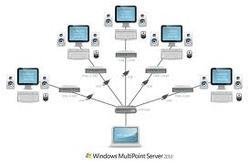Benefits and Constraints of using Thin Client
Thin Client
This is a piece I completed for my college HND in Electrical engineering 👾
What is Thin Client?

A thin client is a centrally managed computing system. This system consists of a centrally located server which provides service to the rest of the ‘clients’ in the building. The reason these computers are now called ‘client’ is because each station now only consists of a monitor, keyboard and mouse. This is why the name ‘Thin’ is appropriate as much less hardware is used within the set-up. This is one of the key long term saving points when installing Thin Client into a college. As thin client consists of one server, the system is less prone to malware attacks and has a longer life cycle compared to the traditional computer station found in higher education and workplaces.
Effects of Having High ICT Usage
It is estimated that ICT accounts for 2% of global carbon dioxide emissions, and that its use in UK further and higher education generates over 500,000 tonnes of carbon dioxide emissions per year. The UK government has a target to reduce carbon dioxide emissions by 26% from 1990 levels by 2020. Personal computing (PCs, laptops, monitors) is the main area of ICT-related energy consumption in UK universities and colleges, at 40–50% of the total, and digital printing is a further 10–16%.
The Climate Change Act (2008) sets a legally binding target for reducing UK carbon dioxide emissions by 80% from 1990 levels by 2050. It also sets up the Carbon Reduction Commitment (CRC), which requires many universities and large colleges to monitor their electricity consumption and purchase carbon credits. There will be penalties for poor performance, and rewards for good performance.
Figures relating to ICT use at the University of Sheffield, Lowestoft College and City College Norwich, when scaled up, suggest that UK further and higher education:
· Uses 1,468,000 computers, 246,000 printers and 238,000 servers
· Had ICT-related electricity bills of about £116 million in 2009
· Emits more than 500,000 tonnes of carbon dioxide a year through its ICT use
ICT is used to administer payroll, admissions and student records, as well as in e-learning. Although it brings clear benefits of administrative efficiency and increased effectiveness in teaching and research, it is accompanied by an environmental and monetary cost. This cost is increasing considerably as new activities and applications are added to existing ones. For example:
· e-Learning, and especially versions with rich media content, are increasing the storage and processing of information within data centres, which are very energy-intensive
· Ever larger volumes of data, from research records to email archives, are being stored
· Many areas of research are becoming more computing-intensive
In the US, data centres account for 1.5% of national electricity consumption, and this is probably also true in the UK. And the figure is rising: the SusteIT survey found that 63% of institutions are expecting to invest in more servers over the next two years. As with PCs, the production of servers has a hidden environmental impact. They are also heavy consumers of electricity, and this is exacerbated by the use of expensive air conditioning to cool data centres.
In some places, such as central London, the electricity grid is near capacity, which sets limits on further data centre expansion. Printers are another major expense, and one that is getting out of control in some institutions, as a result of the trend away from centralised printing to localised printing, and the increased use of colour printers and multifunctional devices. (Multifunctional devices can cut costs and energy consumption if they genuinely replace other devices such as photocopiers, but in a straight comparison with ordinary printers, they are more inefficient.) Higher education has an estimated 148,000 printers, while further education has 98,000. The SusteIT survey found that respondents were printing an average of 224 sheets a week, or 10,000 a year. In larger institutions, this represents an annual cost of £1 million. While ICT use increases steadily, there is growing pressure from government to reduce the environmental and social impact of ICT.
Expected Benefits of Thin Client

Flexible working and technologies such as conferencing can reduce travel, and enable better use of space, which in turn reduces the environmental impact of building use. Evidence suggests that the opportunity to work flexibly is valued highly by staff.
The vision is to be a learning hub, providing opportunities for all through local access to learning, assessment and qualifications, drawing from and contributing to global resources in learning. The mission is shaped by people – learners, staff and stakeholders - people are at the centre of our College’s mission.
Sustainable ICT is an area of growing concern to both suppliers and major users, and so they need employees and advisers who understand the issues. This provides an opportunity for new vocational and academic courses, and creates a new research agenda, and accompanying funding.
For learners
The benefits to learners will be that Thin Client will be able to provide a high quality learning experience, meeting the needs and aspirations of individuals, our communities and business.
For staff
The benefits College staff will receive are increased job satisfaction. This will come by encouraging informed participation in decision-making, ensure equality of opportunity and provide professional and personal development.
For stakeholders
The aim is to provide an efficient, effective and responsive college.
• Widening Access
• Quality
• Innovation & Responsiveness
• Flexibility
• Collaboration
Draw Backs of Thin Client
Although Thin Client brings immense benefits, there are some major draw backs whilst the implementation process takes place. In order for such a complex system to run smoothly and have a maximum benefit to an institution such as Glasgow Clyde College, huge amounts of time must be put into training staff on use, maintaining and repairing Thin Client.
Lack of staff time and resources
College staff lacks the time to deal with the challenges of sustainable ICT, which may be complex and time-consuming. IT departments already face increasing demands from their institutions, without a commensurate increase in staff. Many of the programming changes required to implement sustainable ICT require considerable technical skill to implement. These constraints will become less pressing as college staff become more familiar with the issues.
Budgetary constraints
Many universities and colleges feel they are under-funded, and a lack of capital budget means there is not enough money to spend on sustainable ICT activities: most capital budget for ICT has to be spent on activities that contribute to immediate goals. Universities and colleges are further disadvantaged because they do not qualify for Enhanced Capital Allowance. Savings from energy efficiency measures will result in lower operational costs, but normal budgeting systems make it difficult to transfer money saved from operational costs to a capital budget.
Lack of information and guidance
Because the issue of sustainable ICT is relatively new, many people, particularly teaching and research staff, do not know where they can find relevant information and guidance about it. Especially confusing is the fact that a number of vendors claim that their products are ‘green’. A common problem is that much of the ICT equipment used in the institution is not owned by the IT department, so it is hard to carry out an audit of what is owned by whom, and how energy-efficient it is. The situation is exacerbated by the lack of standardised metrics to assess the energy efficiency of ICT equipment.
A good understanding of the energy consumption associated with specific computer tasks is a prerequisite for better management, but without this kind of information it is difficult to set targets for, and therefore to measure the success of, sustainable ICT projects.
Lack of awareness
Many higher education staff, particularly those in teaching and research, lack detailed knowledge about the issue of ICT and sustainability.
Lack of good procurement practice
Good procurement practice – buying ICT equipment that is energy-efficient and has a small environmental footprint over its lifetime – can make a marked difference to institutional performance. This is particularly true of devices that are regularly replenished, such as PCs and servers.
It can be hard to implement better procurement, however, because:
· There is no well-developed labelling scheme that makes it possible to assess the environmental performance of a piece of equipment through its lifecycle (although this may be available in future)
· In many recent invitation to tender (ITT) processes, there is little or no consideration of environmental and social issues
· Universities are often unfamiliar with techniques to estimate the total cost of ownership (TCO) of ICT equipment over its lifetime, or fail to use them in decision making. Hence, they often underestimate the long-term energy costs associated with ICT.
· The SusteIT survey found that only 17% of respondents conducted detailed TCO assessments
The situation is further complicated by the fact that, within an institution, procurement is rarely the responsibility of a single department: purchases can be made by IT departments, by academic departments and by individuals. IT departments may make their purchases independently or through national or regional agreements negotiated by the sector’s purchasing consortia. This means that institutions working within an agreement cannot easily change its basic terms and specifications.
Thanks for taking the time to read my work. If you have any questions about thin client, or engineering as a whole. Please send me a message.
Happy steeming people 😃
@k-mcg